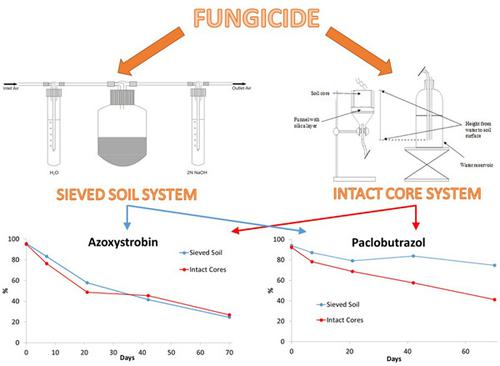当前位置:
X-MOL 学术
›
Environ. Toxicol. Chem.
›
论文详情
Our official English website, www.x-mol.net, welcomes your
feedback! (Note: you will need to create a separate account there.)
The Impact of Disturbed Soil Structure on the Degradation of 2 Fungicides Under Constant and Variable Moisture
Environmental Toxicology and Chemistry ( IF 3.6 ) Pub Date : 2021-07-20 , DOI: 10.1002/etc.5167 Laurence H Hand 1 , Samantha J Marshall 1 , Christine Dougan 1 , Carol Nichols 1 , Aniko Kende 1 , Karl Ritz 2 , Robin G Oliver 1
Environmental Toxicology and Chemistry ( IF 3.6 ) Pub Date : 2021-07-20 , DOI: 10.1002/etc.5167 Laurence H Hand 1 , Samantha J Marshall 1 , Christine Dougan 1 , Carol Nichols 1 , Aniko Kende 1 , Karl Ritz 2 , Robin G Oliver 1
Affiliation

|
Degradation of agrochemicals in soil is frequently faster under field conditions than in laboratory studies. Field studies are carried out on relatively undisturbed soil, whereas laboratory studies typically use sieved soil, which can have a significant impact on the physical and microbial nature of the soil and may contribute to differences in degradation between laboratory and field studies. A laboratory study was therefore conducted to determine the importance of soil structure and variable soil moisture on the degradation of 2 fungicides (azoxystrobin and paclobutrazol) that show significant differences between laboratory and field degradation rates in regulatory studies. Degradation rates were measured in undisturbed cores of a sandy clay loam soil (under constant or variable moisture contents) and in sieved soil. For azoxystrobin, degradation rates under all conditions were similar (median degradation time [DegT50] 34–37 d). However, for paclobutrazol, degradation was significantly faster in undisturbed cores (DegT50 255 d in sieved soil and 63 d in undisturbed cores). Varying the moisture content did not further enhance degradation of either fungicide. Further examination into the impact of soil structure on paclobutrazol degradation, comparing undisturbed and sieved/repacked cores, revealed that the impact of sieving could not be mitigated by repacking the soil to a realistic bulk density. Examination of fungal and bacterial community structure using automated ribosomal spacer analysis showed significant initial differences between sieved/repacked and intact soil cores, although such differences were reduced at the end of the study (70 d). The present study demonstrates that disruption of soil structure significantly impacts microbial community structure, and for some compounds this may explain the differences between laboratory and field degradation rates. Environ Toxicol Chem 2021;40:2715–2725. © 2021 SETAC
中文翻译:

恒定和可变水分条件下土壤结构扰动对2种杀菌剂降解的影响
田间条件下土壤中农用化学品的降解通常比实验室研究更快。实地研究是在相对未受干扰的土壤上进行的,而实验室研究通常使用筛过的土壤,这会对土壤的物理和微生物性质产生重大影响,并可能导致实验室研究和实地研究之间的降解差异。因此,进行了一项实验室研究,以确定土壤结构和可变土壤水分对 2 种杀菌剂(嘧菌酯和多效唑)降解的重要性,这两种杀菌剂在监管研究中显示出实验室和现场降解率之间的显着差异。在砂质粘土壤土(在恒定或可变的水分含量下)和过筛土壤的未扰动岩心中测量降解速率。对于嘧菌酯,所有条件下的降解率相似(中位降解时间 [DegT50] 34-37 天)。然而,对于多效唑,原状岩心的降解速度明显更快(过筛土壤中的 DegT50 255 d 和原状岩心中的 63 d)。改变水分含量并没有进一步增强任一种杀菌剂的降解。进一步研究土壤结构对多效唑降解的影响,比较未扰动和过筛/重新填充的岩心,发现通过将土壤重新填充到实际容重不能减轻过筛的影响。使用自动核糖体间隔分析对真菌和细菌群落结构的检查表明,筛分/重新包装和完整的土壤核心之间存在显着的初始差异,尽管这种差异在研究结束时(70 天)有所减少。环境毒物化学2021;40:2715–2725。© 2021 SETAC
更新日期:2021-07-20
中文翻译:

恒定和可变水分条件下土壤结构扰动对2种杀菌剂降解的影响
田间条件下土壤中农用化学品的降解通常比实验室研究更快。实地研究是在相对未受干扰的土壤上进行的,而实验室研究通常使用筛过的土壤,这会对土壤的物理和微生物性质产生重大影响,并可能导致实验室研究和实地研究之间的降解差异。因此,进行了一项实验室研究,以确定土壤结构和可变土壤水分对 2 种杀菌剂(嘧菌酯和多效唑)降解的重要性,这两种杀菌剂在监管研究中显示出实验室和现场降解率之间的显着差异。在砂质粘土壤土(在恒定或可变的水分含量下)和过筛土壤的未扰动岩心中测量降解速率。对于嘧菌酯,所有条件下的降解率相似(中位降解时间 [DegT50] 34-37 天)。然而,对于多效唑,原状岩心的降解速度明显更快(过筛土壤中的 DegT50 255 d 和原状岩心中的 63 d)。改变水分含量并没有进一步增强任一种杀菌剂的降解。进一步研究土壤结构对多效唑降解的影响,比较未扰动和过筛/重新填充的岩心,发现通过将土壤重新填充到实际容重不能减轻过筛的影响。使用自动核糖体间隔分析对真菌和细菌群落结构的检查表明,筛分/重新包装和完整的土壤核心之间存在显着的初始差异,尽管这种差异在研究结束时(70 天)有所减少。环境毒物化学2021;40:2715–2725。© 2021 SETAC











































 京公网安备 11010802027423号
京公网安备 11010802027423号